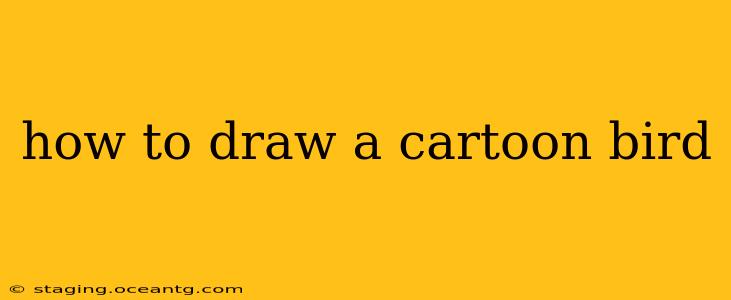How to Draw a Cartoon Bird: A Step-by-Step Guide
Drawing a cartoon bird can be a fun and rewarding experience, whether you're a seasoned artist or just starting out. This guide will walk you through a simple method, perfect for beginners, while offering tips for adding your own unique style. We'll cover different aspects, answering common questions along the way.
1. Starting with the Basic Shapes:
The key to drawing any cartoon character is to start with simple shapes. For our bird, we'll use circles and ovals.
- The Body: Begin by drawing a slightly elongated oval or circle for the bird's body. This will be the largest shape in your drawing.
- The Head: Add a smaller circle on top of the body, slightly overlapping. This will be the bird's head.
- The Beak: Draw a small triangle or a slightly curved shape attached to the bottom of the head for the beak. Experiment with different beak shapes – a pointy beak for a more aggressive bird, a rounder beak for a friendly one.
2. Adding the Details: Wings and Tail
Now let's add the defining features of a bird:
- The Wings: Draw two slightly curved shapes extending from the sides of the body. These can be simple teardrop shapes or more complex, depending on the bird type you want to create. Consider adding a few small lines to suggest feathers.
- The Tail: Add a fan-shaped tail at the bottom of the body. You can make it simple or add detail with individual feathers.
3. Eyes and Feet: Bringing Your Bird to Life
Adding the eyes and feet gives your bird personality:
- The Eyes: Draw two small circles for the eyes. You can add smaller circles inside for highlights to make them sparkle. Consider adding simple eyebrows to express emotion.
- The Feet: Draw two small, slightly pointed shapes at the bottom of the body for the feet. You can add three short lines at the end of each foot to represent toes.
4. Refining and Adding Your Personal Touch:
Once you have the basic shapes in place, it's time to refine your drawing:
- Smoothing the Lines: Carefully smooth out the lines where the different shapes meet.
- Adding Feathers: Add more detailed feather lines to the wings and tail to give your bird more texture.
- Adding Color: Use your favorite colors to bring your bird to life! Consider using different shades to create depth and dimension.
5. Experimenting with Different Styles:
Now that you have the basics, let's explore some variations:
- Different Bird Types: Experiment with different body shapes and beak sizes to create different types of birds – a plump robin, a sleek swallow, or a comical penguin!
- Expressions: Change the position of the eyes and eyebrows to express different emotions – happy, sad, angry, or surprised.
- Adding Accessories: Get creative and add accessories like a hat, scarf, or even glasses to your bird!
H2: How do I draw a cartoon bird's face?
The face is key to your bird's personality! Start with the basic head circle. Then, add the beak (remember, shape is crucial here – pointy, round, curved?), two simple circles for eyes (add highlights for sparkle!), and maybe some small shapes for eyebrows to convey emotion.
H2: What are some easy cartoon bird drawings for beginners?
The method described above is ideal for beginners. Start with the simplest shapes, don't worry about perfection, and focus on having fun! A simple robin or a basic bluebird are great starting points.
H2: How can I draw a realistic-looking cartoon bird?
While we are focusing on cartoon birds, you can achieve a more realistic look by paying more attention to feather detail. Instead of just suggesting feathers with simple lines, add more detailed and varied lines to imitate the texture of actual feathers. You can also use shading and highlights to create a more three-dimensional effect.
H2: How do I make my cartoon bird look cute?
Large, round eyes, a small, rounded beak, and soft curves throughout the body usually create a cute effect. Consider using pastel colours and adding simple details, like rosy cheeks.
Remember to practice and have fun! The more you draw, the better you'll get at capturing your unique style. Don't be afraid to experiment and make mistakes – it's all part of the learning process.
